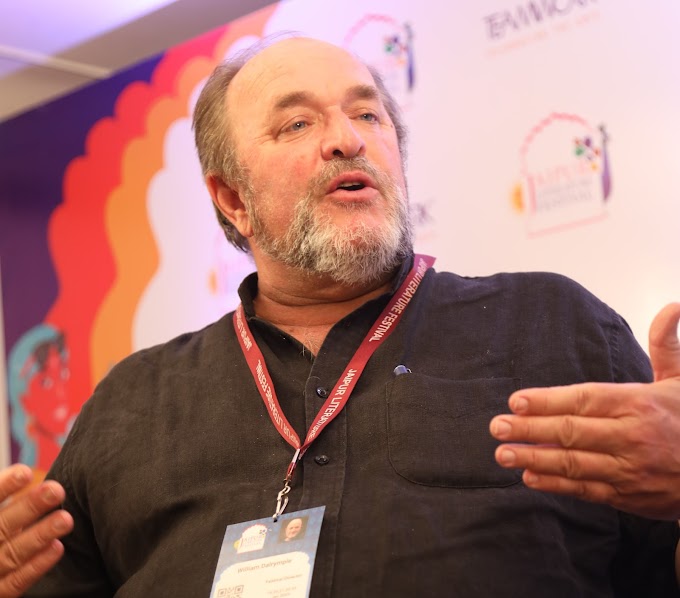It was 5 PM on a quiet Wednesday evening. The sun, like a well-paced storyteller, was gradually inching toward the horizon. Its golden traces were shining its last lights of the day on the young trees of Ashoka University's empty campus on the outskirts of India’s national capital. The scene was one of expectancy, as though the campus itself was holding its breath, waiting for students to return and turn its dormant quiet into a hum of learning and life.
Professor Saikat Majumdar, a distinguished novelist, critic,
and (then) Head of Creative Writing at Ashoka University, appeared on screen
for this interview. Despite the physical distance of a virtual conversation,
his presence carried with it the gravitas of a scholar and the charm of a
storyteller. Prof. Majumdar, this chronicler could soon make out, symbolised an
extraordinary blend that was marked by his journey through the labyrinth of
academia and literature. Though he is celebrated mostly for his poignant novels,
his deep reflections on education and writings in the newspapers are also
eagerly awaited by his regular readers. There was a warmth in his demeanour, which
instantly transformed this interview into an intimate classroom as it became a
space for sharing, questioning, and exploring the potential of the written word.
The Roots of a Literary Life
Born and raised in Calcutta, Prof. Majumdar’s early years were
shaped by his hunger for stories. The Cultural Capital of India, as
it was often called, offered him a dual inheritance of English and Bengali
literature. He devoured the classics with the intensity of a young mind
discovering its calling, finding solace and stimulation in the pages of books
borrowed from the British Council Library. These were the formative years that sowed
the seeds of a literary imagination that would later find utterance in his
novels.
One encounter that stands out vividly even today is with the
legendary Purushottama Lal, founder of the Writer’s Workshop and a luminary in
Indian letters. Lal’s encouragement and belief in young Saikat’s talent resulted
in the publication of some of his earliest stories. It was the first moment of
validation for the young writer but little did anyone know then that this boy,
with dreams scribbled in notebooks, would go on to teach at Stanford University
and Wellesley College, and write novels whose shelf-span will only increase
with the passing time.
The Alchemy of Teaching and Writing
If there is one thread that binds Prof. Majumdar’s life as a
novelist and an academic, it is his love for teaching. At Ashoka University, the
great Indian experiment to elevate the standard of higher education in India at
par with the best in the world, he maintained, he found an environment that
celebrates intellectual curiosity. Here, Prof. Majumdar said, teaching is not
merely a transfer of knowledge but a vibrant exchange of ideas. Professors at
Ashoka are not just educators—they are researchers, writers, and thinkers who
actively contribute to their fields. For him, this dual identity as a
teacher and writer is a powerful synergy.
“There’s something wild about writing,” he muses. “It’s like
life, it happens everywhere, and you cannot leave any slice out.” Writing, for Prof.
Majumdar, is a deeply personal act, an exploration of the self and the world
through language. Unlike other art forms that appeal directly to the senses,
literature is mediated through the artificial construct of language. It is this
intellectuality, this deliberate artifice, that makes literature unique, and
uniquely challenging.
The Middle Finger: A Melting Pot of Experiences
The backdrop of this interview was the release of Prof. Majumdar’s
novel, The Middle Finger, that embodies the convergence of his
experiences as a writer and a teacher. Set in a campus, the novel unfolds
through the perspectives of two female characters and navigates the complex
terrain of equity, access, and the student-teacher relationship. In imagining a
contemporary retelling of the Ekalavya myth, Prof. Majumdar delves into the
moral ambiguities and ethical dilemmas of education.
“The campus is a fascinating space,” he reflected. “It’s where
ideas are born and contested, where identities are shaped, and where the
personal often collides with the political.” Through The Middle Finger, he
offers a lens to examine these dynamics, weaving fiction with threads of
reality drawn from his own encounters in classrooms across India and the West.
What makes this novel particularly intriguing is its poetic
undercurrent. Though he modestly claims that he has never been a poet, the
protagonist of The Middle Finger is one. In crafting her voice, Prof. Majumdar
found himself venturing into the lyrical, the ephemeral, a territory that, in
his words, can only be discovered through the act of writing itself.
On the Intellectual and the Sensual
Prof. Majumdar’s reflections on literature revealed a profound
understanding of its role in human life. “Literature,” he said, “is the most
intellectual of all art forms.” Unlike music or visual arts that engage the
senses directly, literature demands an active participation of the intellect. He
shared that it is through language, a construct as artificial as it is
transformative, that literature touches the depths of human experience.
Yet, for all its intellectual rigor, literature is also deeply
sensual. In his novels, this duality comes alive. Whether it is the haunting
landscapes of The Firebird, the cloistered world of The Scent of God,
or the poetic introspections of The Middle Finger, his works carry a
sensitivity that transcends the written usual shelf, at least for this reader.
Today is the publication day for The Amateur, a book I feel I’ve been writing all my life. An excerpt in the @LAReviewofBooks: “Is there such a thing as the posture of reading? When you look like you’re reading but in fact you’re not?” Link: https://t.co/9wjCWwD1JE pic.twitter.com/zWesYdL5JZ
— Saikat Majumdar (@_saikatmajumdar) July 11, 2024
The Teacher Who Writes, The Writer Who Teaches
For Prof. Majumdar, the line between teaching and writing has become
porous after several years of constant engagement with students on all aspects
of writing. “Teaching feeds my writing,” he admitted, “and writing, in turn,
enriches my teaching.” This symbiotic relationship is also seen in his ability
to bridge the intellectual and the emotional, the personal and the universal.
His classroom, much like his novels, is a space where stories are not just told
but also lived by his pupils.
Prof. Majumdar, notably, brings to life complex ideas in his
newspaper columns. He contextualises them in the everyday struggles and
aspirations of contemporary India. His op-eds frequently examine the
intersections of literature, politics, and pedagogy. They weave personal
insights with cultural critique. For instance, his reflections on the state of
Indian higher education not only dissect systemic challenges but also celebrate
the transformative potential of liberal arts learning. In such writings, he is
perhaps advocating for a model of education that marks a return to the
humanities as a space for fostering critical thinking and ethical citizenship.
@thewire_in asked me about a book that moved me. "Here and Hereafter: Nirmal Verma’s Life in Literature", a wondrous literary biography by Vineet Gill. Begins in the style of an experimental novel with Verma’s death, and offers striking insights about world literature. Link below pic.twitter.com/vCy5Vf068M
— Saikat Majumdar (@_saikatmajumdar) December 27, 2024
What distinguishes his newspaper columns is his ability to
humanise broad sociocultural phenomena through intimate, often anecdotal
lenses. Whether delving into the solitary struggles of a writer, the challenges
of sustaining creativity in an age of distraction, or the nuanced dynamics of
caste and privilege in academic institutions, his pieces have retained a deep
sensitivity to individual experience, which is actually a great thing to achieve for any columnist.




